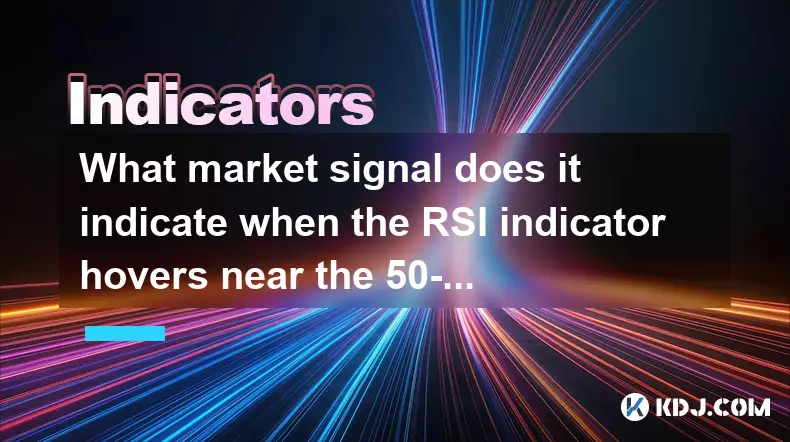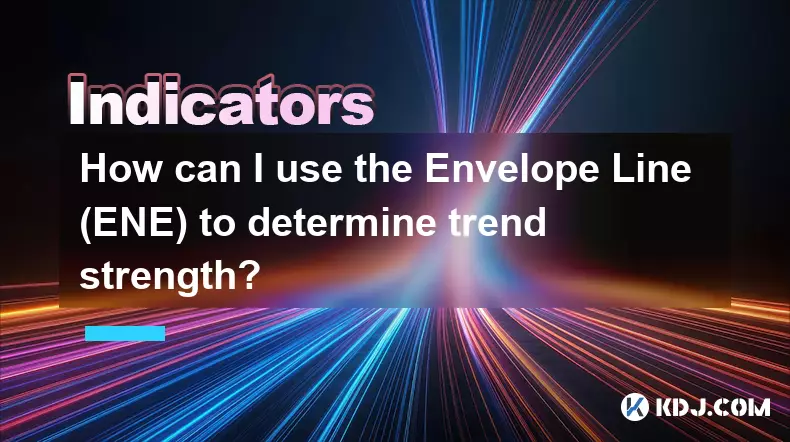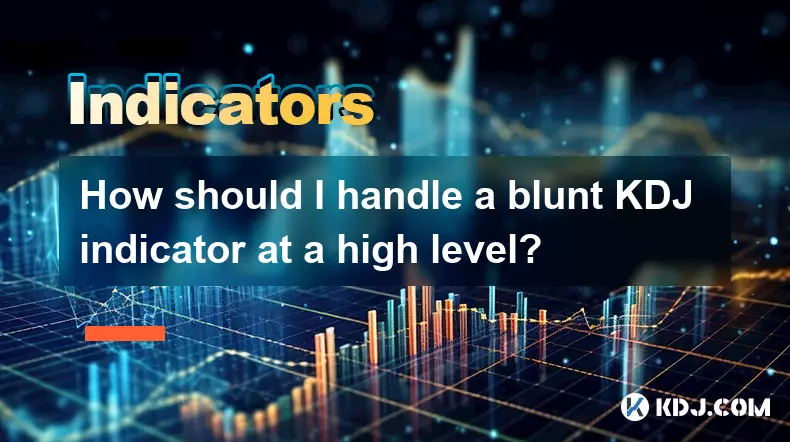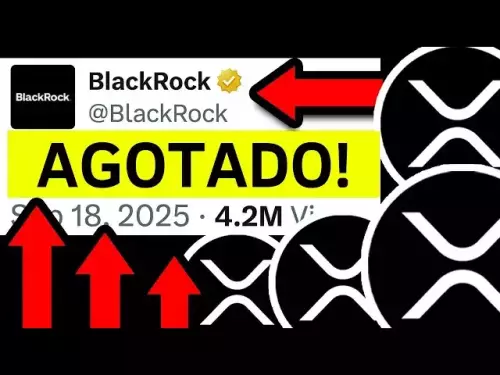-
 bitcoin
bitcoin $115761.354377 USD
-1.37% -
 ethereum
ethereum $4475.268687 USD
-2.95% -
 xrp
xrp $2.997758 USD
-2.97% -
 tether
tether $1.000517 USD
0.02% -
 bnb
bnb $986.306400 USD
-0.03% -
 solana
solana $239.777963 USD
-3.17% -
 usd-coin
usd-coin $0.999885 USD
0.01% -
 dogecoin
dogecoin $0.266431 USD
-5.31% -
 tron
tron $0.344054 USD
-2.27% -
 cardano
cardano $0.895891 USD
-3.84% -
 hyperliquid
hyperliquid $56.136248 USD
-3.59% -
 chainlink
chainlink $23.595739 USD
-4.88% -
 avalanche
avalanche $33.902799 USD
-4.84% -
 ethena-usde
ethena-usde $1.001134 USD
0.02% -
 sui
sui $3.673881 USD
-5.41%
What market signal does it indicate when the RSI indicator hovers near the 50-day moving average?
When RSI and the 50-day MA converge near neutral levels, it signals market indecision, often preceding a breakout or consolidation in crypto markets.
Sep 09, 2025 at 08:18 pm

Understanding the RSI and 50-Day Moving Average Convergence
1. When the Relative Strength Index (RSI) hovers near the level that corresponds with the 50-day moving average of price, it often reflects a period of market equilibrium. This alignment suggests that momentum is neither strongly bullish nor bearish, indicating traders are in a state of hesitation. The market lacks clear direction, which can precede either a breakout or a consolidation phase.
2. The 50-day moving average is widely watched by institutional and retail traders alike as a benchmark for intermediate-term trends. When the RSI, a momentum oscillator, begins to mirror behavior around this average—especially when both indicators converge around neutral territory—it signals that recent price changes are balanced between buying and selling pressure.
3. In cryptocurrency markets, where volatility is amplified, such convergence may point to accumulation or distribution phases. Whales and algorithmic trading bots often operate during these periods, setting positions before the next directional move. Traders monitoring on-chain data alongside technical indicators might notice increased wallet activity even when price action appears stagnant.
4. Another interpretation arises when the RSI fluctuates just above and below the 50 mark while price trades near the 50-day MA. This repeated crossing can act as a confirmation of indecision. It’s not uncommon for false breakouts to occur under these conditions, leading to stop-loss triggers and short-term liquidations across leveraged positions.
5. In trending markets, deviation between the RSI and the 50-day MA typically expands. Therefore, their proximity suggests trend weakening. For example, in a strong uptrend, the RSI often remains above 50, and price stays well above the 50-day MA. When they begin to converge, it may indicate that the trend is losing steam, potentially opening the door for a reversal or sideways movement.
Behavioral Implications in Crypto Trading
1. Market psychology plays a critical role when technical indicators align near neutral zones. Traders tend to become cautious when momentum indicators like the RSI show no clear bias. This psychological pause often results in tighter ranges and reduced order book depth, increasing susceptibility to sudden spikes from large market orders.
2. In decentralized exchanges (DEXs), where liquidity can be fragmented, the convergence of RSI and the 50-day MA may coincide with impermanent loss recalibrations for liquidity providers. Automated market makers adjust pricing based on volume and volatility, and neutral momentum readings can lead to narrower liquidity bands.
3. Social sentiment analysis tools often reflect flat or mixed emotions during these phases. Crypto Twitter and Telegram groups may show increased debate over whether the asset will resume its prior trend or reverse. This divergence in opinion fuels uncertainty, reinforcing the technical signal of balance.
4. Algorithmic trading strategies frequently include filters based on RSI and moving average crossovers. When both indicators hover near each other, many automated systems enter “wait” mode, reducing trade frequency. This decline in algorithmic execution can temporarily lower market efficiency and amplify the impact of news-driven moves.
5. Stablecoins play an indirect but important role during such periods. As traders exit leveraged positions and park funds in USDT or DAI, the inflow into stable assets increases. On-chain metrics like exchange netflow of stablecoins can provide early clues about whether the neutrality is a pause before continuation or the beginning of a broader risk-off shift.
Historical Patterns in Major Cryptocurrencies
1. Bitcoin has exhibited multiple instances where the RSI approached 50 while price tested the 50-day MA, particularly during post-halving consolidations. These episodes often lasted between 10 to 20 days before a decisive move emerged, usually triggered by macroeconomic news or regulatory developments.
2. Ethereum showed similar behavior ahead of major network upgrades. During the transition anticipation phases, price frequently stabilized near the 50-day average while the RSI oscillated around neutrality. Miner and validator behavior, reflected in hash rate and staking withdrawals, often provided additional context to the technical picture.
3. Altcoins with high beta characteristics, such as SOL or AVAX, tend to experience sharper compressions in volatility when RSI and moving averages converge. Due to their sensitivity to Bitcoin's movement, these assets may break out earlier than larger caps, offering leading signals for broader market direction.
4. Exchange-traded volume during these convergence periods often shifts toward perpetual futures with funding rates nearing zero. This balance indicates neither long nor short dominance, reinforcing the idea of market equilibrium. Arbitrage opportunities between centralized and decentralized platforms may briefly emerge due to slight pricing discrepancies.
5. One notable pattern is the increase in options open interest at at-the-money strike prices during these phases. Market makers adjust implied volatility assumptions, and gamma exposure becomes more symmetric, reducing the likelihood of sharp pinning effects until a new directional bias forms.
Frequently Asked Questions
What does it mean when RSI stays near 50 for several days?It indicates balanced momentum, where gains and losses over the lookback period are nearly equal. In crypto, prolonged RSI-50 readings often precede volatility expansions, especially if accompanied by declining volume.
Can the 50-day MA and RSI predict reversals?They do not predict reversals directly but help identify weakening trends. A crossover or sustained divergence after convergence may signal a potential shift, particularly when confirmed by volume spikes or on-chain catalysts.
Is the RSI more reliable in bull or bear markets?The RSI tends to remain elevated in strong bull markets and depressed in bear markets. Its reliability improves when used to spot divergences—for instance, price making new highs while RSI fails to exceed prior peaks, suggesting underlying weakness.
How should traders respond to RSI and 50-day MA convergence?Traders often adopt range-bound strategies, placing buy orders near support and sells near resistance. Tight stop-losses and position sizing adjustments are common, given the uncertainty. Monitoring order book dynamics and funding rates adds valuable context.
Disclaimer:info@kdj.com
The information provided is not trading advice. kdj.com does not assume any responsibility for any investments made based on the information provided in this article. Cryptocurrencies are highly volatile and it is highly recommended that you invest with caution after thorough research!
If you believe that the content used on this website infringes your copyright, please contact us immediately (info@kdj.com) and we will delete it promptly.
- Dogecoin, ETFs, and Returns: What's the Hype?
- 2025-09-20 18:25:12
- Coinbase's Crypto Super App Ambitions: Bank Replacement or Pipe Dream?
- 2025-09-20 18:25:12
- Bitcoin ETF Inflows: Riding the Market Momentum Wave
- 2025-09-20 18:30:13
- Queen Elizabeth 50p Coin: Rare Sales and Collector Mania!
- 2025-09-20 18:30:13
- Queen Elizabeth 50p Coin: Rare Sales and Royal Treasures!
- 2025-09-20 18:35:12
- Grok-4-Fast: xAI's Unified Reasoning Approach Revolutionizes Tool-Use RL
- 2025-09-20 18:35:12
Related knowledge

How can I use the psychological line (PSY) to determine market sentiment?
Sep 17,2025 at 02:19pm
Understanding the Psychological Line (PSY) in Cryptocurrency TradingThe Psychological Line, commonly referred to as PSY, is a momentum oscillator used...

What does a death cross of the RSI in the strong zone (above 50) mean?
Sep 17,2025 at 10:54pm
Understanding the Death Cross in RSI Context1. The term 'death cross' is traditionally associated with moving averages, where a short-term average cro...

How can I use the Envelope Line (ENE) to determine trend strength?
Sep 19,2025 at 05:00pm
Understanding the Envelope Line (ENE) in Crypto TradingThe Envelope Line, commonly referred to as ENE, is a technical indicator used in cryptocurrency...

How should I handle a blunt KDJ indicator at a high level?
Sep 18,2025 at 09:19pm
Understanding a High-Level Blunt KDJ Indicator1. The KDJ indicator, widely used in cryptocurrency trading, combines the stochastic oscillator principl...

How do I interpret a golden cross above the zero line on the MACD indicator?
Sep 19,2025 at 05:18pm
Understanding the MACD Indicator Structure1. The MACD (Moving Average Convergence Divergence) indicator consists of three main components: the MACD li...

What is the Three Crows candlestick pattern? Is it a scary pattern?
Sep 18,2025 at 03:55am
Understanding the Three Crows Candlestick Pattern1. The Three Crows is a bearish reversal pattern in technical analysis, commonly observed after an up...

How can I use the psychological line (PSY) to determine market sentiment?
Sep 17,2025 at 02:19pm
Understanding the Psychological Line (PSY) in Cryptocurrency TradingThe Psychological Line, commonly referred to as PSY, is a momentum oscillator used...

What does a death cross of the RSI in the strong zone (above 50) mean?
Sep 17,2025 at 10:54pm
Understanding the Death Cross in RSI Context1. The term 'death cross' is traditionally associated with moving averages, where a short-term average cro...

How can I use the Envelope Line (ENE) to determine trend strength?
Sep 19,2025 at 05:00pm
Understanding the Envelope Line (ENE) in Crypto TradingThe Envelope Line, commonly referred to as ENE, is a technical indicator used in cryptocurrency...

How should I handle a blunt KDJ indicator at a high level?
Sep 18,2025 at 09:19pm
Understanding a High-Level Blunt KDJ Indicator1. The KDJ indicator, widely used in cryptocurrency trading, combines the stochastic oscillator principl...

How do I interpret a golden cross above the zero line on the MACD indicator?
Sep 19,2025 at 05:18pm
Understanding the MACD Indicator Structure1. The MACD (Moving Average Convergence Divergence) indicator consists of three main components: the MACD li...

What is the Three Crows candlestick pattern? Is it a scary pattern?
Sep 18,2025 at 03:55am
Understanding the Three Crows Candlestick Pattern1. The Three Crows is a bearish reversal pattern in technical analysis, commonly observed after an up...
See all articles










































































